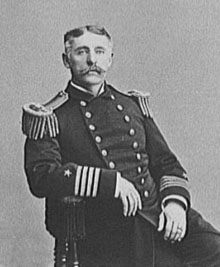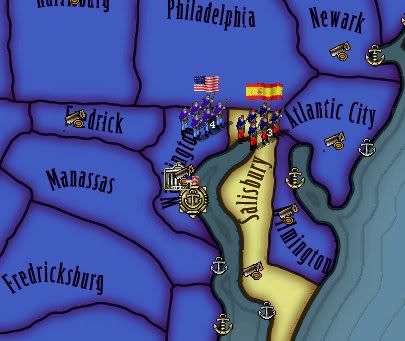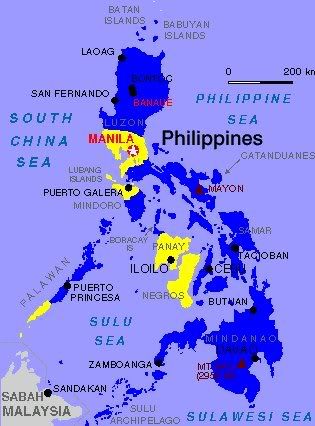The Burning of Baltimore
Admiral George Dewey, commander of the Caribbean Fleet of the US Navy, was the first to engage the European invaders. After receiving orders to sail North and dock in Norfolk before sailing out to defend the Atlantic, Dewey moved his fleet out of the Gulf of Mexico. En-route to Norfolk, the combined fleet of Spanish and French ships caught up with him off the coast of Florida. In the Battle of the Keys, the US fleet attempted to escape into a friendly harbor, even as the French and Spanish ships fired into them. Luckily, for the Americans, it was the Spanish fleet that first engaged. While the French and Americans had progressed at about an even pace, the Spanish were still lagging well behind in the development of naval weapons. The flagship of the Spanish fleet was sunk within ten minutes of the start of the battle.
The sinking of their flag ship sent the Spanish fleet into panic. The captains of the Spanish fleet turned around and fled back towards the gulf, leaving the French to fend for themselves. The French were more than happy to comply. Dewey, trapped in the Keys, dug in for a hard fight. His flag ship, the USS Indiana, was badly damaged, and he lost two battleships to enemy fire. But the French damage was likewise significant. Rather than chase the American fleet as it broke out and limped north, the French fell back to Cuba, nominally to lick their wounds and await the coming of the combined Gulf and Atlantic fleets. But at this point John D. Long, former vice President and current secretary of the Navy, made a grave mistake.
Admiral Dewey
Long ordered Dewey to return to port and repair in Norfolk, and he allowed the French fleet to go un-watched. The French then risked a daring assault. Leaving behind those ships too badly damaged, or too slow, to make the journey, the French and Spanish fleets sailed wide of the Bahamas and traveled up the East Coast of the United States. The French fleet made for, and began bombarding, Boston. Long, furious at the French assault, ordered the Atlantic and Gulf fleets to commit to destroying the French immediately. Even as the last American ship sailed North, the Spanish struck. On April 3rd, the Spanish fleet began bombarding the city of Baltimore, as Spanish troops unloaded North of the city and began a concentrated push southward. The US was caught unaware and unprepared.
General Leonard Wood, who was gathering troops in Washington for a prepared invasion of Cuba after the Franco-Spanish fleet was routed, now had a more immediate threat. Immediately Wood rushed his forces north of the city, to position himself between the Spanish army and the capital. Once position, Wood waited, he knew that before he could move against the Spanish, he needed to equip and prepare, and more importantly, he needed permission to assault an American city. His hesitation was costly. Even as the Spanish army began its assault, the French fleet was engaged by the Americans off the coast of Boston. With the combined might of both the Atlantic and Gulf fleets, Admiral Dewey was able to surround and crush the French fleet. Although most of it survived, the French had to pull back, and leave the American's victorious.
Burning of Baltimore
The Spanish fleet panicked and turned to flee, leaving behind the Spanish army. The Spanish general, enraged, took his frustration out on the city of Baltimore, still putting up some resistance to his occupation. Rather than capture the city, the Spanish army assaulted it. With cannons blasting, the outskirts of the city and those few militia units nearby to defend it were destroyed. With no opposition, the Spanish marched into the city, torches lit. The Spanish army burnt the capital building, and many of the older government buildings to the ground. The government of Maryland fled south to Washington, calling for the federal government to release Wood and send him north. The White House had no choice, Wood was ordered north.
Meanwhile, the secretary of state, Richard Olney, was busy ensuring the United States wasn't alone. After the American invasion of Italy, the French became more and more interested in affecting change in the Italian situation. Eventually, all of Northern Italy fell under the French sphere of influence, much to the chagrin of the Austrian monarchy. Now, with the French navy devastated and her attention turned westward, the Austrians were in a key position to expand their influence. Olney, in only a few days, convinced the Austrians to make their move into Northern Italy. Emperor Franz Joseph was only too happy to comply, and sent in the troops. The French, now realizing that they risked a too front war if they attempted to defend their Italian interests, had to pull back from their conflict with the United States, leaving the Spanish to fend for itself. Now, the real struggle began.






